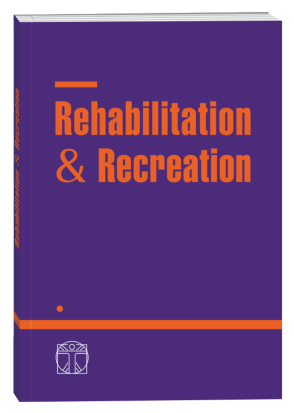INDICATORS OF THE FUNCTIONAL CAPACITY OF THE TISSUES OF THE MAXILLO-FACIAL REGION, THE PSYCHOEMOTIONAL STATE AND THE QUALITY OF LIFE OF PATIENTS WITH THE CONSEQUENCES OF THE MANDIBULAR FRACTURE UNDER THE INFLUENCE OF PHYSICAL THERAPY
DOI:
https://doi.org/10.32782/2522-1795.2024.18.3.5Keywords:
bone fracture, post-immobilization period, physical therapy, rehabilitation in dentistry, maxillofacial region, traumatologyAbstract
Purpose is to assess the effectiveness of the developed physical therapy program based on the dynamics of indicators of the functional capacity of maxillofacial tissue, psychoemotional state and quality of life of patients with the consequences of a mandibular fracture. Material. During the research 77 people were examined. The control group consisted of 32 people without consequences of injuries of the maxillofacial area and burdened dental status. Group 1 consisted of 24 people who underwent rehabilitation according to the general principles of rehabilitation of patients with a dental profile. Group 2 consisted of 21 people with the consequences of a mandibular fracture, who underwent rehabilitation with the use of therapeutic exercises; massage; thermal procedures; postisometric relaxation; kinesiological taping; patient education. Effectiveness was evaluated based on the results of surface electromyography, Hospital Anxiety and Depression Scale, SF-36 questionnaire. The results. In patients in the post-immobilization period after a mandibular fracture, signs of disturbances in the functional state of the neuromuscular apparatus were determined by changes in the amplitude of the bioelectric activity of the masticatory and temporal muscles at rest and when the jaws are maximally clenched in the position of habitual occlusion (according to surface electromyography data), psychoemotional suppression by type of anxiety and depression (according to the Hospital Anxiety and Depression Scale) and, as a result, deterioration of the physical and mental components of the quality of life (according to the SF-36). In patients who received an effect only on the peripheral component of the contracture of the temporomandibular joint (its mobility), a slight improvement in the indicators of bioelectric activity (temporal muscles when clenching the jaws) and certain components of the quality of life (on the scales of general health, vitality, role emotional, mental health) was determined (p<0.05 relative to baseline values), but a decrease in psycho-emotional stress according to the Hospital Anxiety and Depression Scale was not determined (p>0.05). All these diagnosed positive changes were less pronounced (p<0.05) compared to the group that was engaged in the complex physical therapy program. Conclusions. In the rehabilitation program of patients in the post-immobilization period after a fracture of the mandibular fracture, it is advisable to include measures taking into account and correcting not only dental changes, but also the consequences of damage to the tissues of the orofacial zone, neck, and which will improve not only the local condition of the tissues, but also their psycho-emotional status and quality of life.
References
Саєнко О.В., Аравіцька М.Г. Динаміка постіммобілізаційних функціональних обмежень орофаціальної зони у пацієнтів після перелому нижньої щелепи під впливом реабілітаційних засобів. Art of Medicine. 2023. № 4(28). С. 115–120. DOI: 10.21802/artm.2023.4.28.115.
Стандарт медичної допомоги. Невогнепальні переломи нижньої щелепи (виросткового відростка, гілки, кута, тіла та симфізу). URL: https://www.dec.gov.ua/wp-content/uploads/2023/06/1096_16062023_smd.pdf.
Травми щелепно-лицевої ділянки. Клінічна настанова, заснована на доказах. URL: https://www.dec.gov.ua/wp-content/uploads/2023/02/2023_kn_travma.pdf.
Adik K., Lamb P., Moran M., Childs D., Francis A., Vinyard C.J. Trends in mandibular fractures in the USA: A 20-year retrospective analysis. Dent Traumatol. 2023. № 39(5). Р. 425–436. DOI: 10.1111/edt.12857.
Aravitska M.H., Saienko O.V. The influence of physical therapy on indicators of locomotive syndrome in elderly persons with osteoarthritis of the knee and obesity. Clinical and Preventive Medicine. 2023. 4(26). 6–13. DOI: https://doi.org/10.31612/2616-4868.4(26).2023.01.
Amorim C.S.M., Espirito Santo A.S., Sommer M., Marques A.P. Effect of Physical Therapy in Bruxism Treatment: A Systematic Review. J Manipulative Physiol Ther. 2018. № 41(5). Р. 389–404. DOI: 10.1016/j.jmpt.2017.10.014.
Asim M.A., Ibrahim M.W., Javed M.U., Zahra R., Qayyum M.U. Functional Outcomes of Open Versus Closed Treatment of Unilateral Mandibular Condylar Fractures. J Ayub Med Coll Abbottabad. 2019. № 31(1). Р. 67–71.
Azam I., Chahal A., Kapoor G., et al. Effects of a program consisting of strain/counterstrain technique, phonophoresis, heat therapy, and stretching in patients with temporomandibular joint dysfunction: A pilot study. Medicine (Baltimore). 2023. № 102(32). Р. 34569. DOI: 10.1097/MD.0000000000034569.
Boffano P., Roccia F., Zavattero E., et al. European Maxillofacial Trauma (EURMAT) project: a multicentre and prospective study. J Craniomaxillofac Surg. 2015. № 43(1). Р. 62–70. DOI: 10.1016/j.jcms.2014.10.011.
Cabalag M.S., Wasiak J., Andrew N.E., Tang J., Kirby J.C., Morgan D.J. Epidemiology and management of maxillofacial fractures in an Australian trauma centre. J Plast Reconstr Aesthet Surg. 2014. № 67(2). Р. 183–189. DOI: 10.1016/j.bjps.2013.10.022.
Jazayeri H.E., Lopez J., Khavanin N., Xun H., Lee U.K., Best D.L., Reategui A., Urata M.M., Dorafshar A.H. Comparative Benefits of Open versus Closed Reduction of Condylar Fractures: A Systematic Review and Meta-Analysis. Plast. Reconstr. Surg. 2023. № 151. Р. 664e–672e. DOI: 10.1097/PRS.0000.
Koval N.P., Aravitska M.H. Dynamics of kinesiophobia and physical functioning parameters in the elderly adults with sarcopenic obesity under the influence of the physical therapy program. Clinical and Preventive Medicine. 2023. 4(26). 88–95. DOI: https://doi.org/10.31612/2616-4868.4(26).2023.13.
Nesterchuk N.Y., Gamma T.V., & Korobkova R.M. (2024). Characteristics of the quality of life of elderly patients with traumatic damage of the lower jaw as a criterion of the efficiency of rehabilitation intervention. Rehabilitation and Recreation, 18(2), 20–27. https://doi.org/10.32782/2522-1795.2024.18.2.2.
Petronis Z., Spaicyte N., Sakalys D., Januzis G. Functional Rehabilitation after Mandibular Fracture – A Systematic Review. Ann Maxillofac Surg. 2022. № 12(2). Р. 197–202. DOI: 10.4103/ams.ams_99_22.
Tatsumi H., Matsuda Y., Toda E., Okui T., Okuma S., Kanno T. Postoperative Complications following Open Reduction and Rigid Internal Fixation of Mandibular Condylar Fracture Using the High Perimandibular Approach. Healthcare. 2023. № 11(9). Р. 1294. DOI: 10.3390/healthcare11091294.
Downloads
Published
How to Cite
Issue
Section
License
Copyright (c) 2024 O. V. Sayenko, M. H. Aravitska

This work is licensed under a Creative Commons Attribution-NonCommercial-NoDerivatives 4.0 International License.











